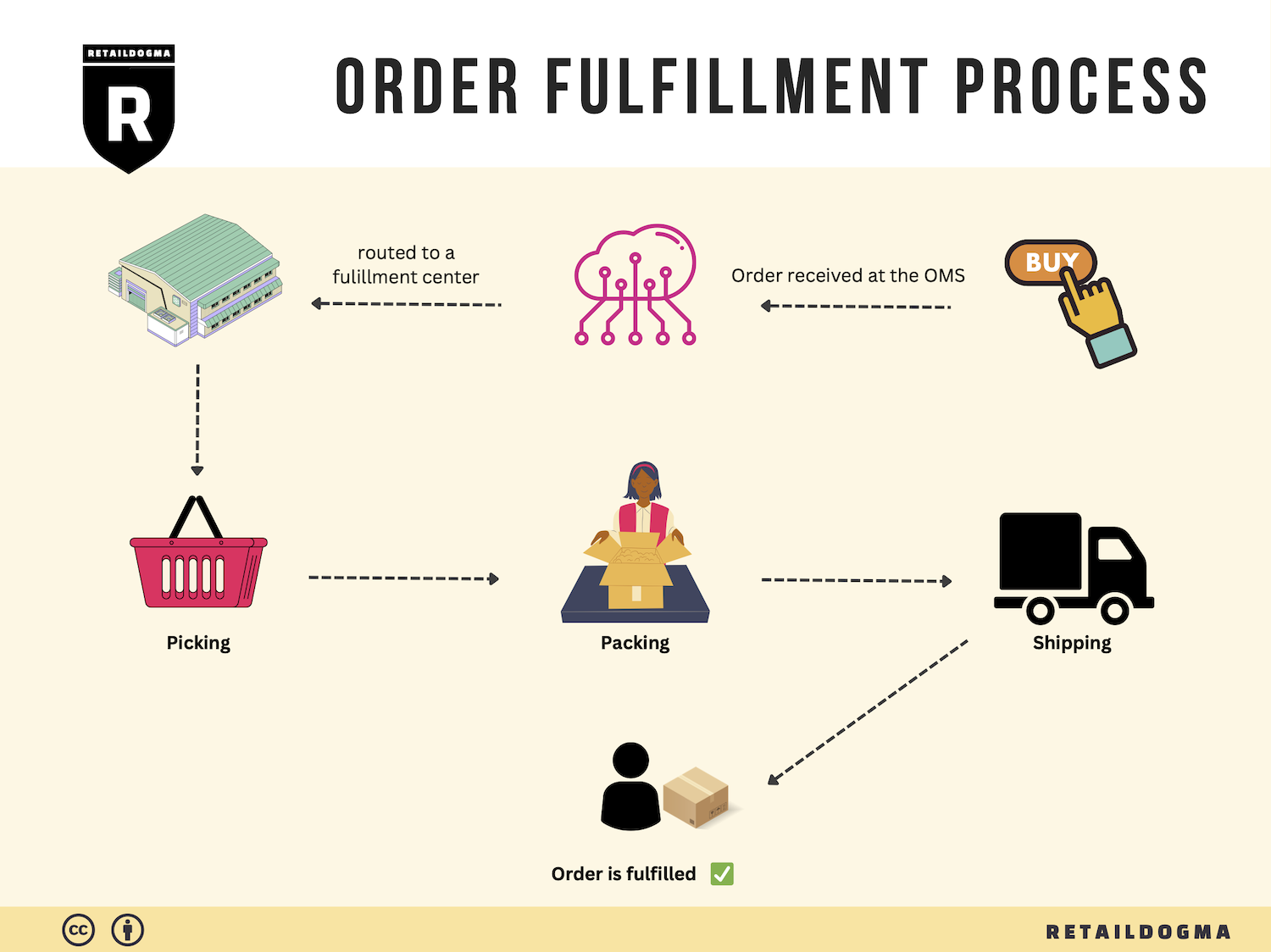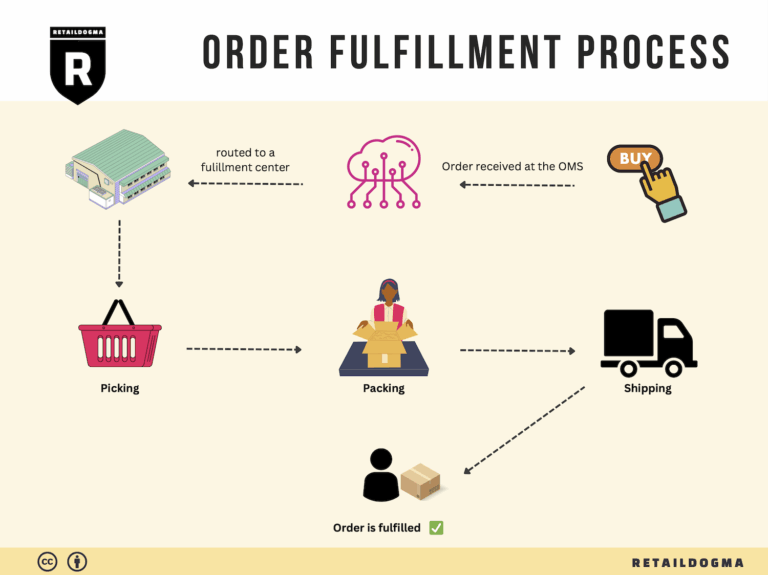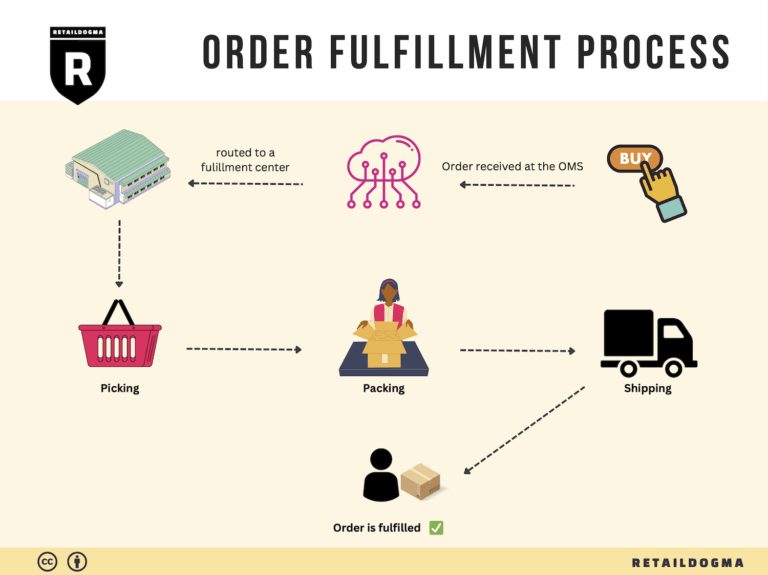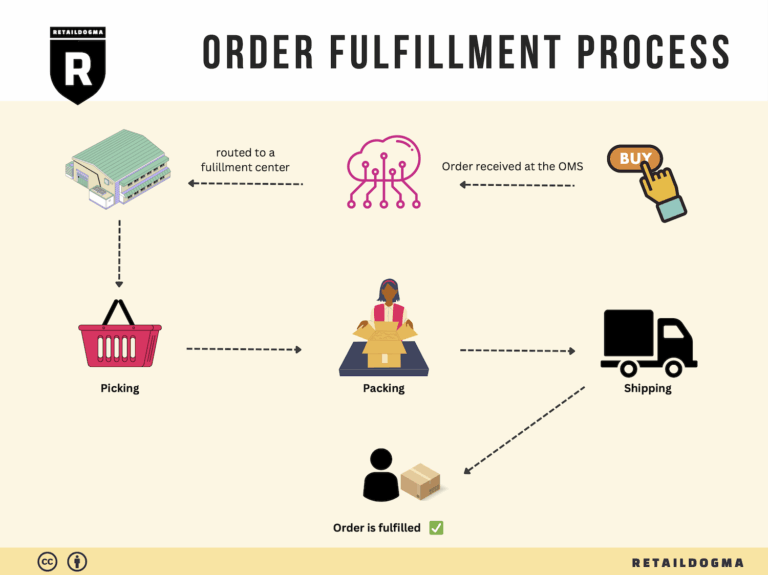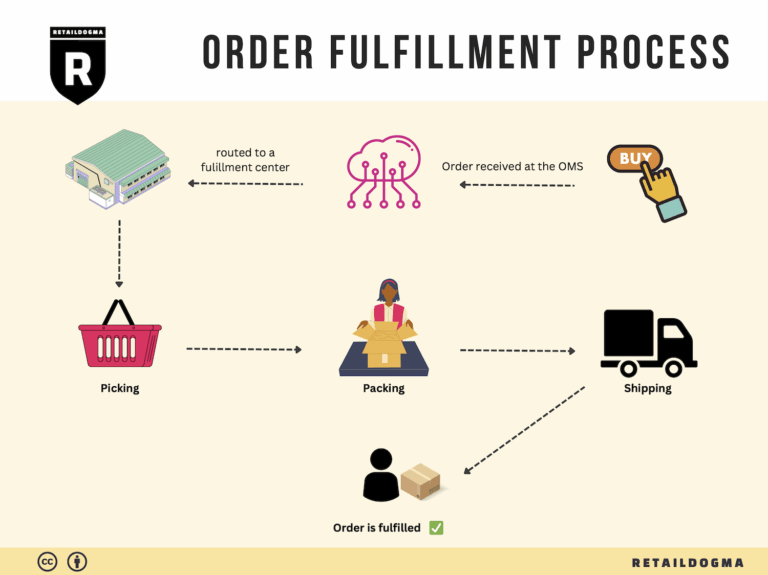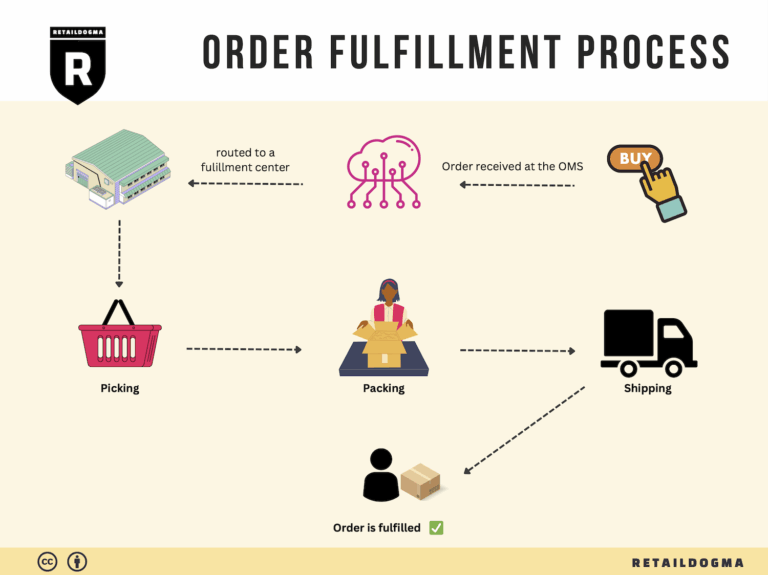What Is A Fulfillment Center? A Complete Guide (2025)
What is E-commerce Fulfillment? An Introduction for Growing Businesses
Understanding E-commerce Fulfillment
As an e-commerce business owner, you may find yourself drowning in the complexities of packing and shipping orders. This common pain point can quickly lead to burnout and inefficiencies, ultimately affecting your customer satisfaction and bottom line. E-commerce fulfillment encompasses the entire process of getting a product from your inventory to the hands of your customer. It is not merely about shipping; it involves a series of steps including inventory management, order processing, packing, and shipping.
In this guide, we will demystify the world of e-commerce fulfillment and provide you with the insights needed to streamline your operations. We’ll explore various fulfillment models, including third-party logistics (3PL) and Fulfillment by Amazon (FBA), both of which can offer distinct advantages depending on your business needs. Understanding these models will empower you to choose the right partner for your logistics.
Core Services of E-commerce Fulfillment
The core services offered by fulfillment providers typically include inventory storage, order processing, packing, shipping, and returns management. Each of these components plays a critical role in ensuring that your customers receive their orders accurately and on time. By leveraging these services, you can focus on growing your business rather than getting bogged down in the details of order fulfillment.
Choosing the Right Fulfillment Partner
Selecting the right fulfillment partner is crucial for scaling your business. Factors to consider include the provider’s location, technology integration capabilities, customer service, and pricing structures. A well-chosen partner can enhance your operational efficiency and customer satisfaction, while a poor choice can lead to increased costs and delays.
Understanding Pricing Structures
Pricing in e-commerce fulfillment can vary widely based on the services offered, volume of orders, and storage needs. It’s essential to have a clear understanding of how these costs are structured, as they can significantly impact your overall profitability. This guide will help you navigate the different pricing models and what to expect in terms of fees.
Empowering Your Business Decisions
Ultimately, this guide aims to equip you with the knowledge and tools necessary to make informed decisions about your logistics and fulfillment strategies. By understanding the nuances of e-commerce fulfillment, you can optimize your operations, enhance your customer experience, and drive your business toward sustainable growth. Whether you’re just starting out or looking to scale, the right fulfillment strategy can be a game-changer in your e-commerce journey.
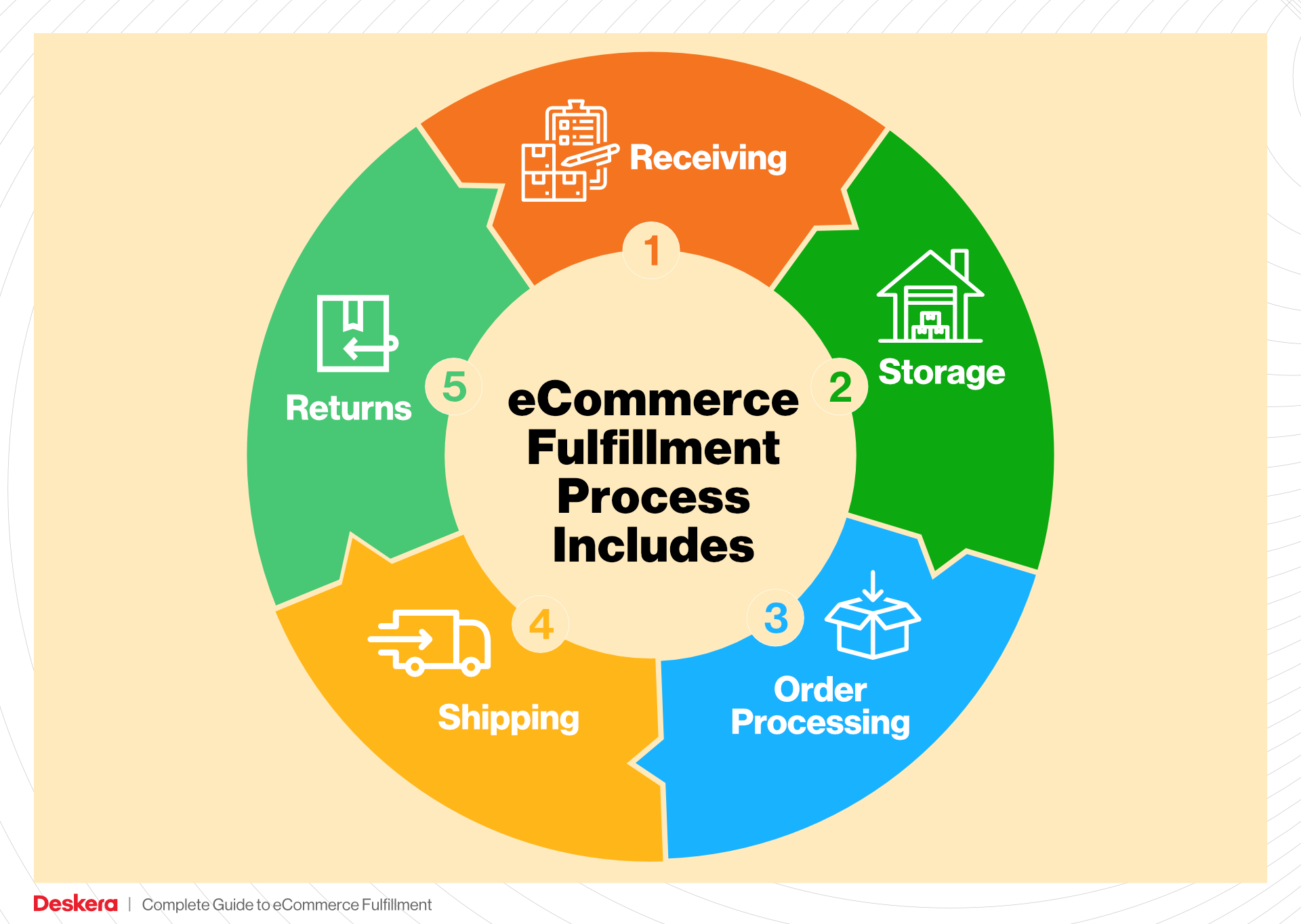
What You’ll Learn In This Guide
- What is E-commerce Fulfillment? An Introduction for Growing Businesses
- The Order Fulfillment Process: From ‘Buy’ Button to Customer’s Door
- Comparing Fulfillment Models: In-House vs. 3PL vs. Dropshipping
- A Deep Dive into Amazon FBA: Pros, Cons, and Who It’s For
- Core Services Offered by Fulfillment Centers
- How to Choose a Fulfillment Partner: A 6-Point Checklist
- Understanding Fulfillment Pricing: A Breakdown of Common Fees
- Frequently Asked Questions (FAQs) about Fulfillment
- Conclusion: Is Outsourcing Fulfillment the Right Move for Your Business?
- Important Disclaimer
The Order Fulfillment Process: From ‘Buy’ Button to Customer’s Door
1. Receiving Inventory
The first step in the order fulfillment process begins when products arrive at the fulfillment center. This involves receiving inventory from suppliers or manufacturers. Each item is checked against a purchase order to ensure accuracy and quality. This step is crucial because any discrepancies can lead to stock shortages or overages, affecting overall inventory management.
During this phase, items are assigned a Stock Keeping Unit (SKU), a unique identifier that helps track inventory levels and sales. Efficient receiving processes minimize the time products spend in transit, allowing for faster order fulfillment. A well-organized receiving area and trained staff can significantly streamline this process, ensuring that products are ready for the next steps quickly.
2. Warehouse Storage
Once the inventory is received and verified, it is stored in designated areas within the warehouse. Effective warehouse storage is essential for maximizing space utilization and ensuring easy access to products when needed. This step often employs techniques such as zoning, where similar items are grouped together, and FIFO (First In, First Out) systems to manage stock rotation.
Proper storage not only improves operational efficiency but also enhances inventory accuracy. Businesses must maintain accurate records of product locations within the warehouse, often using Warehouse Management Systems (WMS) to track inventory levels and locations in real time. This ensures that items can be quickly retrieved during the order-picking phase, ultimately leading to faster order processing and improved customer satisfaction.
3. Order Picking
Order picking is the process of retrieving items from storage to fulfill customer orders. This step is critical as it directly impacts the speed and accuracy of order fulfillment. Pick lists, which detail the items and quantities needed for each order, guide warehouse associates in this process.
There are various picking methods, including single order picking, batch picking, and zone picking, each suited to different types of operations. Implementing an effective picking strategy can significantly reduce the time it takes to fulfill orders. Additionally, automation technologies, such as robotic picking systems, can enhance efficiency and accuracy in this stage, helping businesses scale operations without compromising service quality.
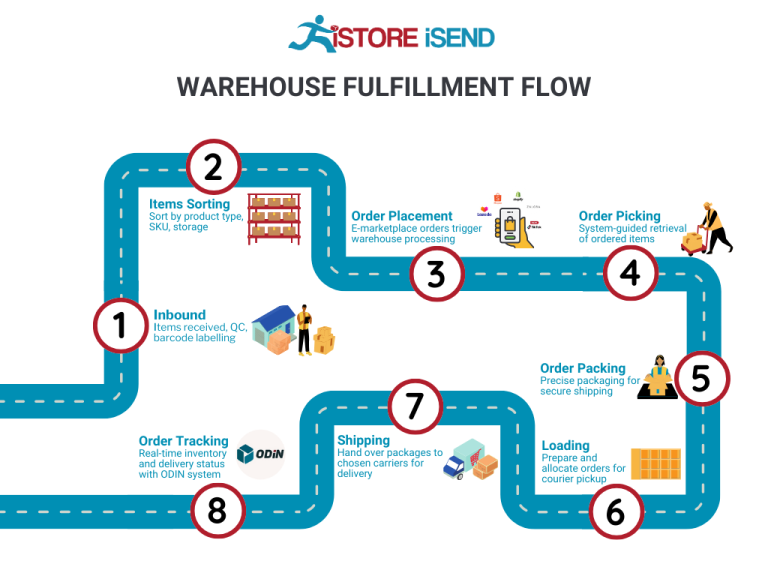
4. Order Packing
After items are picked, they are moved to the packing station, where they are prepared for shipment. This step involves checking the picked items against the order details, packing them securely, and labeling them for delivery. Proper packing is vital to prevent damage during transit, which can lead to costly returns and dissatisfied customers.
Businesses should utilize appropriate packing materials and techniques to protect items based on their nature—fragile items may require bubble wrap or foam, while heavier products might need sturdier boxes. Additionally, incorporating packing slips and return labels can enhance the customer experience. Efficient packing processes can also optimize shipping costs by reducing dimensional weight, ensuring that businesses remain competitive in the e-commerce landscape.
5. Shipping & Delivery
The final step in the order fulfillment process is shipping, where packages are handed off to a carrier for delivery to the customer. This stage is crucial as it determines the speed and reliability of the delivery service. Businesses often use various shipping methods, including standard, expedited, and same-day delivery options, depending on customer expectations and order urgency.
Tracking systems are implemented to provide customers with real-time updates on their order status. This transparency is vital for customer satisfaction and can help mitigate concerns during delays. Additionally, establishing strong relationships with carriers can lead to better rates and service levels. Effective shipping strategies not only enhance the customer experience but also contribute to overall operational efficiency, allowing businesses to scale their logistics effectively.
In conclusion, understanding and optimizing each step of the order fulfillment process—from receiving inventory to shipping and delivery—can significantly impact an e-commerce business’s success. By focusing on efficiency, accuracy, and customer satisfaction, businesses can scale their operations and thrive in a competitive marketplace.
Comparing Fulfillment Models: In-House vs. 3PL vs. Dropshipping
Comparison of Fulfillment Models
| Model | Who Handles Inventory | Best For (Business Stage) | Key Advantage | Key Disadvantage |
|---|---|---|---|---|
| In-House Fulfillment | Business itself | Established businesses | Full control over inventory and processes | High operational costs and complexity |
| Third-Party Logistics (3PL) | Third-party logistics provider | Growing businesses | Scalability and reduced overhead costs | Less control over inventory |
| Dropshipping | Supplier | Startups and small businesses | Low upfront investment and risk | Lower profit margins and dependency on suppliers |
In-House Fulfillment
In-house fulfillment refers to the process where a business manages its own inventory, storage, packing, and shipping. This model is typically employed by established businesses that have the resources and infrastructure to handle logistics internally. The key advantage of in-house fulfillment is the complete control it provides over inventory management, order processing, and customer experience. Businesses can tailor their operations to meet specific customer needs, ensuring a high level of service. However, this model also comes with significant disadvantages. It often entails high operational costs, including warehouse leasing, staffing, and equipment. Additionally, the complexity of managing logistics can divert attention from core business activities, making it challenging for companies to scale efficiently.
Third-Party Logistics (3PL)
Third-party logistics (3PL) involves outsourcing the logistics and fulfillment processes to a third-party provider. This model is best suited for growing businesses that require flexibility and scalability without the burden of managing logistics themselves. By partnering with a 3PL, companies can leverage the provider’s expertise, technology, and infrastructure, allowing them to focus on core business functions such as marketing and product development. One of the primary advantages of 3PL is the reduction in overhead costs associated with warehousing and logistics, as well as the ability to scale operations quickly in response to changing market demands. However, a significant disadvantage is the loss of control over inventory and fulfillment processes. Businesses may face challenges in maintaining quality and consistency in service, which can impact customer satisfaction.
Dropshipping
Dropshipping is a fulfillment model where the retailer does not keep products in stock. Instead, when a retailer sells a product, they purchase the item from a third-party supplier who then ships it directly to the customer. This model is particularly attractive for startups and small businesses due to its low upfront investment and minimal risk. Retailers can offer a wide range of products without the need for inventory, allowing for greater flexibility in product offerings. However, dropshipping comes with notable disadvantages. Profit margins are typically lower compared to other fulfillment models, as retailers must rely on suppliers for inventory and shipping. Additionally, there can be significant challenges in ensuring product quality and shipping times, as the retailer has limited control over these aspects. This dependency can lead to issues with customer satisfaction if the supplier fails to deliver on expectations.
In conclusion, each fulfillment model has its unique strengths and weaknesses, and the right choice depends on the specific needs and stage of the business. Established businesses may benefit from the control of in-house fulfillment, while growing businesses often find value in the scalability of 3PL services. Meanwhile, startups and small businesses can leverage dropshipping to minimize risk and investment while still offering a diverse product range. Understanding these models allows e-commerce businesses to make informed decisions that align with their operational goals and customer expectations.
A Deep Dive into Amazon FBA: Pros, Cons, and Who It’s For
Understanding Fulfillment by Amazon (FBA)
Fulfillment by Amazon (FBA) is a service offered by Amazon that allows e-commerce sellers to store their products in Amazon’s fulfillment centers. Amazon takes care of storage, packaging, and shipping of products directly to the customers. This service not only simplifies the logistics process for sellers but also enhances their visibility on the Amazon marketplace. When customers order products listed through FBA, they benefit from Amazon’s trusted shipping and customer service.
How FBA Works
-
Set Up Your FBA Account: Sellers create an Amazon seller account and choose FBA as their fulfillment method.
-
List Your Products: After setting up the account, sellers list their products on Amazon. They can either create new listings or convert existing ones to FBA.
-
Prepare Your Inventory: Products must be packaged and labeled according to Amazon’s requirements. Sellers can do this themselves or use Amazon’s prep services for a fee.
-
Ship Inventory to Amazon: Sellers send their inventory to designated Amazon fulfillment centers. Amazon provides shipping plans and guidelines to facilitate this process.
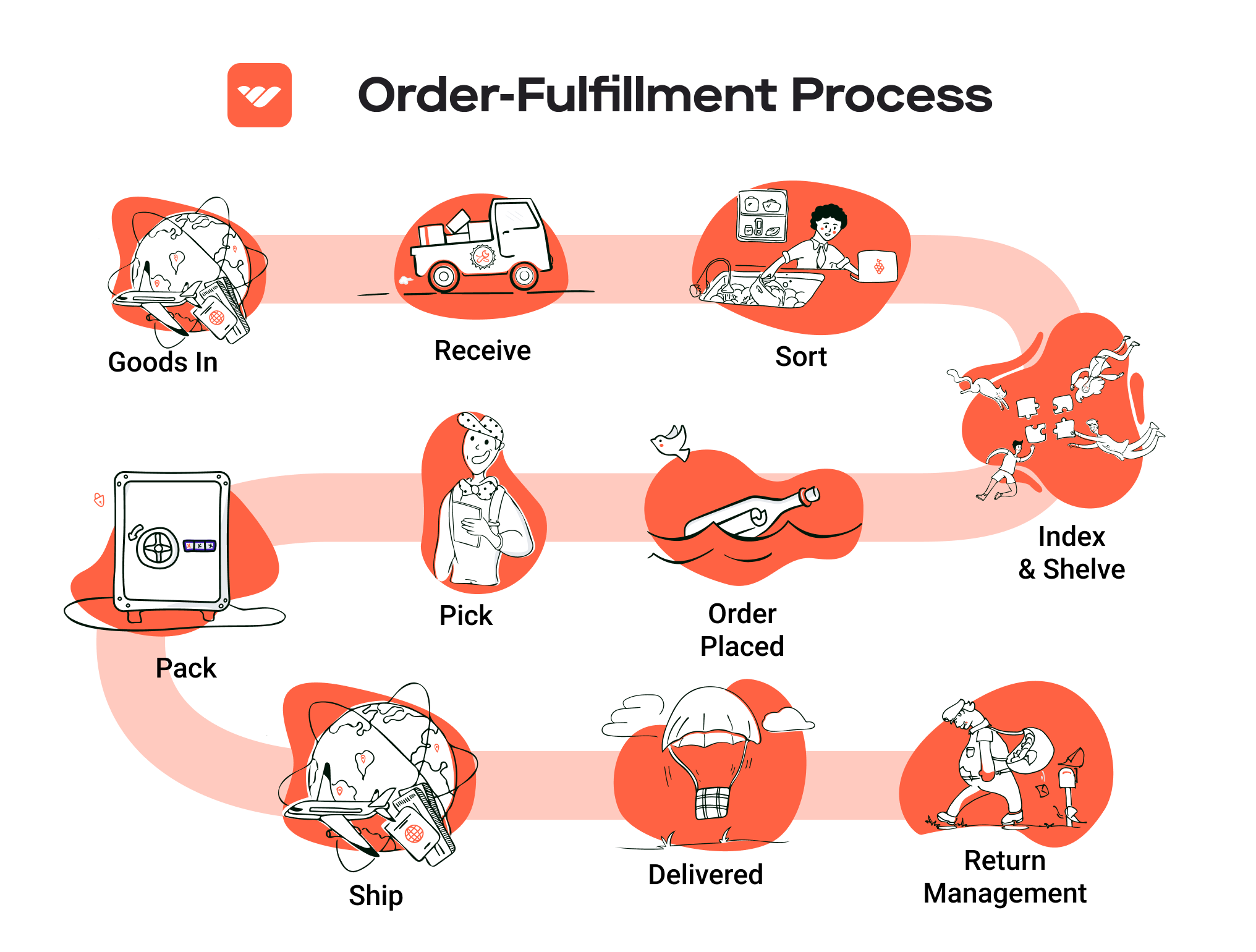
-
Storage and Fulfillment: Once the inventory arrives at Amazon, it is stored until a customer places an order. Amazon handles picking, packing, and shipping the orders.
-
Customer Service and Returns: Amazon manages customer service inquiries and handles returns, providing a seamless experience for both sellers and buyers.
Pros of Using FBA
Prime Eligibility
One of the most significant advantages of using FBA is the eligibility for Amazon Prime. Products fulfilled by Amazon are eligible for Prime shipping, which can significantly boost sales. Prime members often prefer to buy products that offer faster shipping options, leading to increased visibility and sales potential.
Customer Trust
Amazon is a trusted brand in e-commerce, and using FBA can enhance a seller’s credibility. Customers often feel more confident purchasing items fulfilled by Amazon due to the robust customer service and return policies associated with FBA.
Multi-Channel Fulfillment
FBA isn’t limited to sales on Amazon alone. Sellers can utilize Amazon’s fulfillment network to fulfill orders from other sales channels, such as their own websites or other e-commerce platforms. This flexibility allows businesses to streamline their logistics and improve operational efficiency.
Cons of Using FBA
High Fees
While FBA offers many conveniences, it comes with various fees that can cut into a seller’s profits. These include storage fees (charged monthly based on space used) and fulfillment fees (charged per item shipped). For sellers with low margins or slow-moving inventory, these fees can accumulate quickly, impacting profitability.
Strict Inventory Rules
Amazon has stringent inventory management policies. Sellers must adhere to guidelines regarding product preparation, labeling, and inventory limits. Failure to comply can result in additional charges or even the suspension of FBA privileges. This can be particularly challenging for new sellers who are still learning the ropes.
Commingling Risks
With FBA, sellers’ inventory can be commingled with that of other sellers. This means that if one seller’s product is defective or has quality issues, it could affect the reputation of other sellers whose products are mixed in the same inventory pool. Sellers may face challenges in tracking returns and managing their reputation in the marketplace.
Who is FBA Best For?
FBA is an excellent option for various types of sellers, but it particularly benefits:
-
Small to Medium-Sized Businesses: Those looking to scale quickly without investing heavily in their logistics infrastructure can leverage FBA to access Amazon’s vast customer base.
-
Sellers with High Turnover: Businesses that have products with high demand and quick turnover can benefit from FBA’s streamlined fulfillment process, allowing them to focus on sourcing and marketing.
-
Multi-Channel Sellers: Companies that sell across various platforms can use FBA to fulfill orders from different channels, simplifying their logistics and improving efficiency.
-
New Sellers: For those new to e-commerce, FBA can provide a supportive framework. By utilizing Amazon’s established systems, new sellers can focus on learning the marketplace dynamics without the burden of managing logistics.
In conclusion, while Fulfillment by Amazon provides numerous advantages such as Prime eligibility and enhanced customer trust, it also has its drawbacks, including high fees and strict inventory rules. Understanding these factors will help e-commerce businesses make an informed decision about whether FBA is the right fulfillment solution for their needs.
Core Services Offered by Fulfillment Centers
Inventory Management & Warehousing
Inventory management and warehousing are foundational services provided by fulfillment centers that enable e-commerce businesses to operate efficiently. This service encompasses the storage of products in a controlled environment, where inventory levels are monitored, tracked, and managed in real-time.
Effective inventory management involves various tasks such as receiving shipments, storing goods in designated locations, and maintaining an accurate count of available stock. Fulfillment centers often utilize advanced software systems to track inventory levels, forecast demand, and automate reordering processes.
Benefits to E-commerce Businesses:
1. Reduced Overhead Costs: By outsourcing warehousing to a fulfillment center, businesses can save on the costs associated with maintaining their own storage facilities, including rent, utilities, and labor.
2. Scalability: Fulfillment centers offer flexible storage solutions that can easily scale up or down based on seasonal demand fluctuations or business growth, allowing e-commerce owners to avoid the pitfalls of overstocking or stockouts.
3. Improved Inventory Accuracy: Advanced technology employed by fulfillment centers enhances inventory accuracy, which directly leads to better decision-making and improved customer satisfaction.
Pick and Pack Services
Pick and pack services are critical components of the order fulfillment process, ensuring that products are accurately selected and prepared for shipment. This service involves picking the ordered items from storage, packing them securely, and labeling them for delivery.
Fulfillment centers employ systematic methods for picking, such as batch picking or zone picking, which streamline the process and reduce picking errors. Packing involves using appropriate materials to safeguard items during transit, ensuring they arrive at the customer’s doorstep in pristine condition.
Benefits to E-commerce Businesses:
1. Faster Order Processing: The expertise of fulfillment centers in pick and pack operations leads to quicker order turnaround times, enhancing customer satisfaction and loyalty.
2. Error Reduction: Professional packing and picking minimize the risk of shipping incorrect or damaged items, which can lead to costly returns and diminished customer trust.
3. Focus on Core Business Activities: By outsourcing this labor-intensive process, e-commerce businesses can concentrate on strategic areas such as marketing, product development, and customer engagement, ultimately driving growth.
Kitting and Assembly
Kitting and assembly services involve the grouping of various products into ready-to-sell kits or assembling products before they are shipped to customers. This process is particularly beneficial for businesses that sell multi-component items or promotional bundles.
Fulfillment centers can efficiently manage kitting operations, ensuring that all components are included and packaged correctly. They also handle assembly tasks, such as putting together furniture or packaging gift sets, which can be time-consuming for e-commerce businesses if done in-house.
Benefits to E-commerce Businesses:
1. Enhanced Product Offerings: Kitting allows businesses to create unique product bundles that can attract more customers and increase average order value.
2. Streamlined Operations: Outsourcing kitting and assembly reduces the complexity of operations and allows e-commerce businesses to leverage the fulfillment center’s expertise and equipment.
3. Time Savings: By eliminating the need for in-house assembly, businesses can save valuable time that can be redirected towards growth initiatives and customer service.
Returns Management (Reverse Logistics)
Returns management, or reverse logistics, is a crucial service offered by fulfillment centers that deals with the processing of returned items. This service includes receiving returned products, inspecting their condition, restocking them if they are in sellable condition, and managing defective or unsellable items.
Fulfillment centers often implement streamlined processes for handling returns, using technology to track returned items and update inventory levels accordingly. A well-managed returns process is essential for maintaining customer satisfaction and loyalty.
Benefits to E-commerce Businesses:
1. Improved Customer Experience: A hassle-free returns process enhances the shopping experience, as customers feel more confident making purchases when they know they can easily return items if needed.
2. Cost Efficiency: By leveraging the expertise of fulfillment centers, businesses can reduce the costs associated with handling returns, as these centers have established processes and systems in place to manage reverse logistics efficiently.
3. Data Insights: Returns management can provide valuable insights into customer preferences and product performance, helping businesses make informed decisions about inventory, product development, and marketing strategies.
In conclusion, leveraging the core services offered by fulfillment centers—inventory management and warehousing, pick and pack services, kitting and assembly, and returns management—can significantly enhance the operational efficiency of e-commerce businesses. By outsourcing these functions, businesses can focus on their growth strategies while ensuring a high level of customer satisfaction and operational effectiveness.
How to Choose a Fulfillment Partner: A 6-Point Checklist
Location & Warehouse Network
Importance: The geographical location of your fulfillment partner’s warehouses can significantly impact your shipping costs and delivery times. A partner with a strategically located warehouse network can help you reach your customers faster, which is crucial in today’s competitive e-commerce landscape.
Questions to Ask:
– Where are your warehouses located, and how does that align with my customer base?
– Do you have a network of fulfillment centers that can accommodate different regions?
– What is your average shipping time to major metropolitan areas?
Technology & Integrations
Importance: In the fast-paced world of e-commerce, efficient technology is essential for managing inventory, processing orders, and tracking shipments. A fulfillment partner that offers robust technology solutions can streamline operations and improve overall efficiency.
Questions to Ask:
– What technology platforms do you use for inventory management and order processing?
– Can your systems integrate with my existing e-commerce platform (e.g., Shopify, Magento, Amazon)?
– Do you provide real-time tracking and reporting capabilities for shipments?
Specializations (e.g., Cold Storage, Oversized Items)
Importance: Depending on your product range, you may require specialized storage and handling solutions. A partner that can accommodate specific needs, such as temperature-controlled environments for perishable goods or facilities for oversized items, can be invaluable.
Questions to Ask:
– Do you have experience handling products similar to mine (e.g., fragile items, food products)?
– What specialized services do you offer, such as cold storage or custom packaging?
– How do you ensure compliance with regulations for specialized products?
Scalability & Capacity
Importance: As your business grows, your fulfillment needs will evolve. Choosing a partner that can scale with your business is crucial to avoid disruptions in service. A fulfillment partner with flexible capacity can help you manage peak seasons without compromising on service quality.
Questions to Ask:
– How do you handle fluctuations in order volume, such as during holiday seasons?
– What is your current capacity, and how quickly can you scale up if needed?
– Can you provide case studies or examples of how you’ve supported clients through growth phases?
Pricing and Contracts
Importance: Understanding the pricing structure and contract terms is essential to ensuring that you can maintain a profitable margin while using a fulfillment service. Hidden fees and rigid contracts can lead to unexpected costs.
Questions to Ask:
– What is your pricing model (e.g., per order, storage fees, pick and pack fees)?
– Are there any additional fees I should be aware of (e.g., for returns, special handling)?
– What are the terms of your contract, and do you offer flexibility for early termination or changes in service?
Customer Support & Reviews
Importance: Reliable customer support is critical when issues arise. A fulfillment partner that provides excellent customer service can help you resolve problems quickly and maintain a positive customer experience.
Questions to Ask:
– What kind of customer support do you offer (e.g., 24/7 support, dedicated account manager)?
– How do you handle issues related to lost or damaged shipments?
– Can you provide references or reviews from other clients to gauge your service quality?
Conclusion
Choosing the right fulfillment partner is a critical decision that can significantly influence your e-commerce operations. By using this checklist, you can systematically evaluate potential partners to ensure they align with your business needs and growth objectives. Prioritize clear communication and thorough understanding during the selection process, as these factors will contribute to a successful partnership in the long run.
Understanding Fulfillment Pricing: A Breakdown of Common Fees
Initial Setup Fees
Initial setup fees are the costs associated with getting your products integrated into a fulfillment center’s system. These fees can vary significantly based on the complexity of your inventory and the fulfillment provider’s requirements. Typically, these fees may include:
- Account Setup: This could involve creating your seller account, integrating your inventory management systems, and ensuring your products meet the fulfillment center’s standards.
- Product Listing Fees: Some centers charge fees for listing each product or SKU in their system, especially if it requires additional data entry or categorization.
- Labeling Fees: If your products require barcodes or labels before they can be stored, you may incur additional fees for printing and applying these labels.
To calculate initial setup fees, assess the number of SKUs you will be using and inquire about any specific requirements that might add to the costs. Understanding these upfront can help you budget accordingly.
Receiving Fees
Receiving fees are charged when your inventory arrives at the fulfillment center. These fees cover the labor and processes involved in unloading, inspecting, and entering your products into the warehouse management system.
- Fee Structure: Receiving fees are often charged per pallet or per item. For example, a fulfillment center might charge a flat rate for each pallet received or a variable fee based on the total number of units.
- Inspection and Handling: If your products require special handling or inspection (e.g., fragile items), additional charges may apply.
To calculate receiving fees, consider the volume of inventory you plan to ship and whether any special handling is necessary. Always ask for a detailed breakdown of what the receiving fee includes to avoid surprises.
Storage Fees (per pallet/bin)
Storage fees are incurred for keeping your inventory in the fulfillment center’s warehouse. These fees are typically charged on a monthly basis and can vary based on the type of storage used.
- Pallet Storage: This is a common pricing model where you pay a set fee per pallet of goods stored. This fee can vary based on the season, with higher costs during peak periods such as the holiday season.
- Bin Storage: For smaller items that don’t take up an entire pallet, fulfillment centers may charge by the bin or shelf space used. This model can be beneficial for businesses with diverse product lines.
To effectively manage storage fees, regularly monitor your inventory levels and adjust your stock accordingly. Consider the storage fees as part of your overall inventory management strategy, and aim to minimize excess stock.
Pick & Pack Fees (per item/order)
Pick and pack fees refer to the costs associated with selecting items from storage and preparing them for shipment. This is a critical part of the fulfillment process and can significantly impact your overall costs.
- Per Item Fee: Many fulfillment centers charge a fee for each item picked and packed. This could be a flat rate or vary based on the complexity of the order (e.g., multi-item orders might incur higher fees).
- Order Complexity: If your order requires special packaging or additional handling, this may also lead to increased pick and pack fees.
To optimize your pick and pack fees, consider streamlining your product offerings and minimizing the number of SKUs in each order. This can lead to more efficient operations and lower costs.
Shipping Fees
Shipping fees are the costs associated with delivering your products to customers. These can be one of the most variable costs depending on factors such as package weight, dimensions, destination, and shipping speed.
- Carrier Rates: Fulfillment centers often partner with various carriers, and shipping fees can vary based on the selected carrier and service level (e.g., standard, expedited).
- Dimensional Weight Pricing: Some carriers charge based on the dimensional weight of the package rather than the actual weight, which can affect pricing for larger, lighter items.
To get accurate shipping quotes, consider the dimensions and weights of your products, as well as the geographic distribution of your customer base. Regularly review carrier contracts and negotiate rates to ensure you are getting the best deal.
Conclusion: Tips for Getting an Accurate Quote
- Provide Detailed Information: When requesting a quote, provide as much detail as possible about your inventory, shipping volumes, and specific requirements.
- Ask for Itemized Quotes: Ensure the quote breaks down each fee type. This transparency helps you understand where costs arise and allows for better budgeting.
- Evaluate Seasonal Variations: Inquire about how fees may change during peak seasons and plan your inventory and budget accordingly.
- Compare Providers: Don’t settle for the first quote you receive. Compare multiple fulfillment centers to ensure you get the best rates and services.
- Negotiate: Don’t hesitate to negotiate fees, especially if you have a significant volume of business or long-term plans with the fulfillment center.
By understanding these fulfillment pricing models, you can better prepare your e-commerce business for scaling while managing costs effectively.
Frequently Asked Questions (FAQs) about Fulfillment
1. What is a fulfillment center?
A fulfillment center is a specialized warehouse designed to manage the storage, processing, and shipping of products for e-commerce businesses. Unlike traditional warehouses that may focus primarily on storage, fulfillment centers handle the entire order processing cycle, from inventory management to packaging and shipping directly to customers.
2. What is the difference between a warehouse and a fulfillment center?
The primary difference lies in their functions:
– Warehouse: Typically focuses on storing goods for longer durations and may not handle the order fulfillment process.
– Fulfillment Center: Aims to quickly process and ship orders, often using advanced technology to manage inventory and streamline logistics. Fulfillment centers are essential for businesses that require fast and efficient order processing.
3. What roles are available at Amazon fulfillment centers?
Amazon fulfillment centers offer a variety of roles, including:
– Fulfillment Center Associate
– Warehouse Team Lead
– Operations Manager
– Inventory Control Specialist
– Robotics Technician
These positions cater to different skill levels and experiences, providing opportunities for both entry-level workers and seasoned professionals.
4. How much do Amazon fulfillment center jobs pay?
Salaries for positions at Amazon fulfillment centers vary based on role, location, and experience. Entry-level positions often start around $19 per hour, with potential for overtime and benefits that begin on the first day of employment. Higher-level roles, such as managers or specialists, can earn significantly more.
5. What benefits do Amazon fulfillment center employees receive?
Employees at Amazon fulfillment centers typically enjoy a comprehensive benefits package that includes:
– Health, dental, and vision insurance
– Paid time off and holidays
– Retirement savings plans with company matching
– Employee discounts and perks
These benefits contribute to a supportive work environment focused on employee well-being.
6. What is a 3PL (Third-Party Logistics)?
A 3PL is a service provider that offers logistics services to businesses, including transportation, warehousing, and fulfillment. Companies often partner with 3PLs to outsource their logistics needs, allowing them to focus on core business operations while leveraging the expertise and infrastructure of logistics providers.
7. How does Amazon’s fulfillment process work?
The fulfillment process at Amazon typically involves:
1. Receiving inventory at the fulfillment center.
2. Storing products in organized locations.
3. Picking items from shelves when an order is placed.
4. Packing the selected items securely for shipment.
5. Shipping the packages to customers, often using Amazon’s delivery network.
This streamlined process ensures quick and accurate order fulfillment.
8. How much do fulfillment services cost?
The cost of fulfillment services can vary widely based on factors such as storage space, order volume, and shipping distances. Generally, fulfillment centers charge for:
– Storage fees (monthly per cubic foot)
– Pick and pack fees (per item or order)
– Shipping costs (based on weight and destination)
It’s essential for businesses to evaluate their specific needs to understand the potential costs involved.
9. What skills are needed to work at an Amazon fulfillment center?
Key skills for success in Amazon fulfillment center roles include:
– Attention to detail for accurate order processing
– Physical stamina for tasks involving lifting and moving products
– Basic computer skills for inventory management systems
– Strong communication skills for teamwork and collaboration
– Adaptability to work in a fast-paced environment
10. How can I apply for a job at an Amazon fulfillment center?
To apply for a position at an Amazon fulfillment center, visit Amazon.jobs and search for available roles in your desired location. You can submit your application online, and if you need assistance during the application process, Amazon provides resources for individuals with disabilities. Additionally, you can sign up for job alerts to stay informed about new openings.
Conclusion: Is Outsourcing Fulfillment the Right Move for Your Business?
The Strategic Advantage of Outsourcing Fulfillment
Outsourcing fulfillment can be a transformative decision for e-commerce businesses aiming to scale efficiently. One of the most significant benefits is time savings. By delegating logistics operations to a fulfillment service, business owners and operations managers can focus on core activities such as marketing, product development, and customer engagement. This shift not only enhances productivity but also fosters innovation, as teams can dedicate their efforts to strategic growth initiatives.
Scalability is another critical advantage. As your business grows, so do the complexities of managing inventory, shipping, and customer service. Fulfillment partners offer the infrastructure and resources needed to handle increased order volumes seamlessly. This flexibility allows you to respond quickly to market demands without the burden of investing in additional warehousing or staffing.
Moreover, partnering with a fulfillment expert brings invaluable industry knowledge and technology. These providers are often equipped with advanced systems that optimize inventory management, enhance order accuracy, and improve delivery times. By leveraging their expertise, your business can benefit from best practices that may be challenging to implement independently.
However, the success of outsourcing fulfillment hinges on selecting the right partner. It’s crucial to evaluate potential providers based on their track record, technology capabilities, and alignment with your business goals. A well-chosen partner can be a catalyst for growth, while a poor fit may hinder progress.
As you consider your logistics strategy, take a moment to audit your current shipping processes. Assess whether your existing operations are equipped to support your growth ambitions. If not, exploring a fulfillment partner might be your next strategic move. Embrace the opportunity to enhance efficiency and focus on what truly matters: delighting your customers and expanding your brand.
Important Disclaimer
⚠️ Important Disclaimer
The information in this guide is for educational purposes. Fulfillment services, pricing, and platform features change frequently. Always conduct your own due diligence and consult with providers directly before making business decisions.
